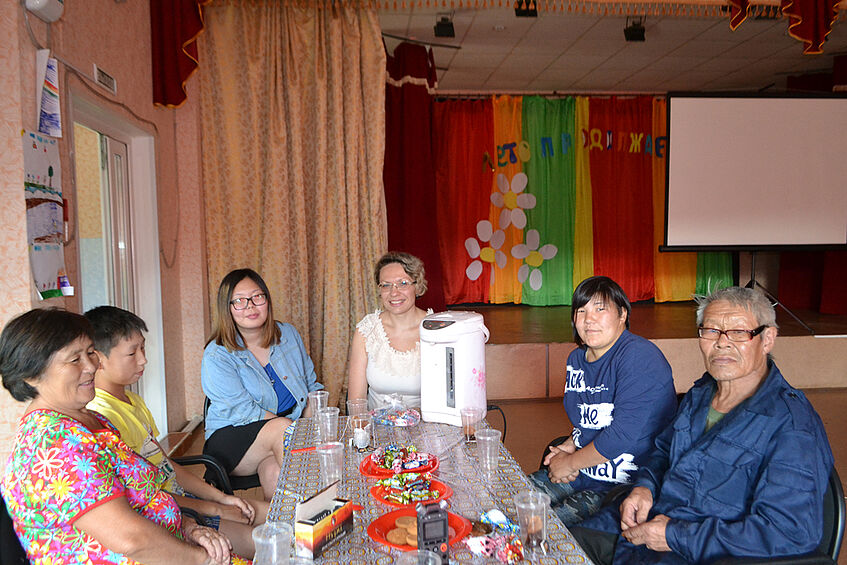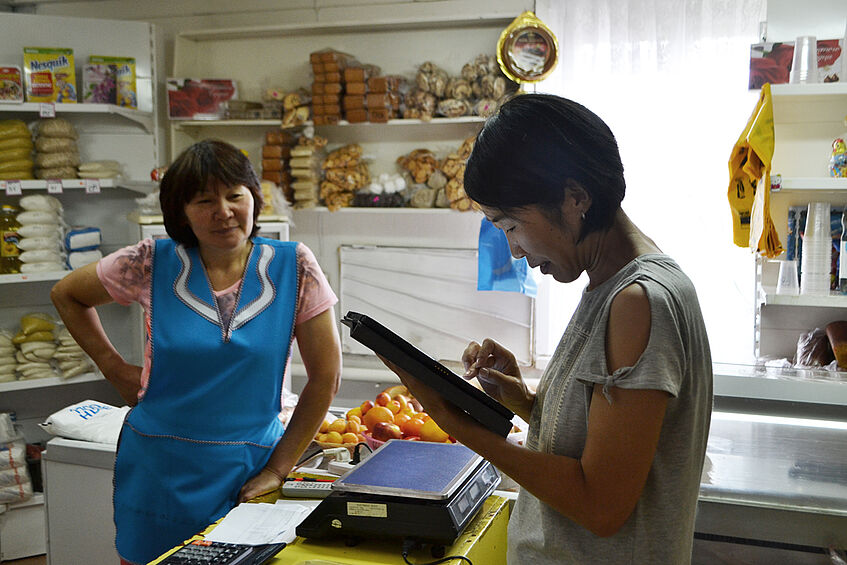Fieldwork, June 30 - August 4 2017
Field sites and methods

Railway station at Larba 17.07.2017 built by a Team from Uzbekistan. © Olga Povoroznyuk
Field sites and methods
The fieldwork in Tynda and Tyndinskiy District on Jul 13-18 included in-depth interviews with BAM builders and work with statistics, documents, photo materials and other objects in the archives of the BAM history museum and the district archive, both of them based in Tynda. An introductory trip to 3 railroad settlements Larba, Khorogochi, Kuvykta and indigenous Evenki village Ust’-Urkima, conducted together with PL Peter Schweitzer, was part of the intense research program in Tyndinskiy District. It included meetings with administrations of the settlements, documentation (photos) of the local infrastructures (buildings, railway stations), as well as spontaneous encounters and informal communication with local residents, children, passengers waiting for commuter trains, and railway stations’ personnel. In Ust’-Urkima, we had an opportunity for another CoRe presentation and a follow up focus group interview in the round table format. The events were attended by the local indigenous intelligentsia (kindergarten nurses, school teachers, librarians) and village and the district administrations.
The village of Ust-Nyukzha was founded as a trading post (faktoriya) in 1923 and is currently home to Russian old settlers, Yakuts and the majority (68% in 2017) of Evenki. It was our first fieldwork in the community initially selected as an important field site popular for its thriving traditional life styles and remote location. In comparison to other indigenous villages in the BAM region, Ust’-Nyukzha counts many non-sedentary Evenki residents, with 8 reindeer herding obschinas registered within the municipality’s boundaries and many more informal nomadic herding families and individual hunters. Another feature that distinguishes the village in the field of indigenous culture and education is a nomadic elementary school, one of very few similar enterprises currently functioning in the Russian North. Although Ust’-Nyukzha is only 7 km. away from the BAM and the railroad settlement of Yuktali, they are separated by the natural boundary – river Nyukzha (tributary to Olekma). The missing bridge and no permanent road connection make Ust’-Nyukzha fully accessible for ground transport and large-scale supply only in winter season. Fieldwork in indigenous Evenki village of Ust’-Nyukzha on Jul 19-24 included introductory project presentation and a follow up community meeting, participant observation of the village life, and a series of in-depth interviews with indigenous people (reindeer herders, education and culture specialists and activists) and Soviet-time migrants to the village.

Community Meeting in Ust'-Nyukzha 20.07.2017 © Zhanna Nikolaeva

"I love Yuktali",Yuktali 24.07.2017 © Olga Povoroznyuk
Neighboring Yuktali was founded as BAM builders’ settlement in 1976 during the construction boom and the massive population inflow to the region. With its communal infrastructure (i.e. the boiler house) initially planned for 20000 residents, Yuktali is now home to only 1615 residents. The overwhelming majority are former BAM builders and employees of state institutions which serve local residents. The present and future of this mono-industrial settlement are fully dependent on the Russian railroads company RZhD and curtailing social services, which once made Yuktali central for other smaller railway settlements (Khorogochi, Kuvykta, etc.) along the BAM. In-depth interviews with BAM builders, as well as communication with RZhD and local administration experts highlighted memories of the BAM construction and current concerns about diminishing state investments in local development.
The fieldwork in the city of Severobaikal’sk and the neighboring indigenous village of Kholodnoe on Jul 25-29 was conducted partially in collaboration with project partner Vera Kuklina. It included a series of interviews with our target groups – BAM builders, indigenous Evenki people, as well as with RZhD managers and workers and SMEs (the latter conducted by Vera). In addition to interviews, I worked with the records of the BAM organizations in the city archive. The documents of trust company “Nizhneangarsktransstroy”, which constructed the city of Severobaykal’sk, the respective railroad section and other key infrastructure objects were especially useful in showing the structure of its organizations, and ethic, social and professional composition of their stuff. Work with museum collections was conducted in the RZhD house of culture, home to a local museum of the BAM history established by activists and regularly supplied with new items by the current and former city residents and builders.

Founders of BAM Museum Severobaykal'sk 26.07.2017 © Olga Povoroznyuk

Vera Kuklina conducting mobility survey at a local shop in Kholodnoe 27.07.2017 © Olga Povoroznyuk
Interviews and observations in Evenki village Kholodnoe reveal predominantly negative impacts of the BAM in past and present. Cultural assimilation through drastic demographic change - inflow of BAM builders and mixed partnerships of the migrants with Evenki residents is one of the BAM affects. Yet, more direct impacts of the railroad are connected with traditional land use and agriculture. Evenki reindeer herders recall about massive reindeer loss during the construction period, when domestic herds were shot and reindeer meet was sold cheaply or exchanged for alcohol. Currently, the local reindeer herding suffers from the lack of federal and regional support, unsettled land conflicts, and social problems (alcoholism, suicides). Whereas BAM is no longer seen as a problem by herders, local cattle breeders whose freely grazing cows are killed by trains, suffer the loss of the cattle and carry responsibility for hindering the traffic. The currently introduced law prescribing significant fines for cattle keepers to RZhd company is a cause of local complains.
In addition to the classical anthropological field methods, we continued our mobility survey and BAM emic maps collection in virtually all of the mentioned above settlements. We also conducted expert interviews in local administrations and gathered general statistical information/reports on demography, economics, and culture of the BAM settlements.
Research questions
- BAM (re)constructed: history and social life of “the project of the century”
We continued collecting the archival data on the Soviet history of the BAM communities, included in the list of our field sites. These data were further complimented by statistics on demographics and oral histories of old settlers and indigenous people. In combination, they give us a comprehensive picture of the BAM as a Soviet advanced technological, development and nation-building project implemented within the “mastering the North” program. - Indigeneity and modernization: stories of Evenki people of the BAM
While the collectivization and sedentarization of indigenous people of the region were the major Soviet development projects, the BAM construction marked the beginning of the region’s large-scale industrialization affecting indigenous Evenki in many ways. Interviews collected in 2017 support our finding regarding BAM impacts on indigenous people. Namely the railroad boosted assimilation processes through intense contacts with migrants and environmental impacts – pollution and destruction of traditional lands and increase of poaching among newcomers. At the same time indigenous villagers recognize the railroad as an infrastructure for mobility, both in geographical and social senses. - Building the BAM-builders: living memories, performing identities
The previous fieldwork experience with bamovtsy has shown that former BAM builders preserve their distinct collective identity. This second field season in the cities of Tynda and Severobaykal’sk has given us a more nuanced understanding of this group identity. It rest on socialist ideology and shared living and working experience in the North, is reinforced in the wake of the new Russian patriotism and commemorated and performed during the public cultural events. - Overcoming remoteness? Technosocial networks and mobilities along the BAM.
This topic focused on the (un)making of remote communities along the legendary railroad as a political, socio-economic and infrastructure process. Field results show contrasting perceptions of remoteness – from the feeling of abandonment prevailing mostly among Soviet migrants, especially in smaller settlements (i.e. Yuktali) to a desired condition among the residents of hardly accessible indigenous village of Ust’-Nyukzha.
